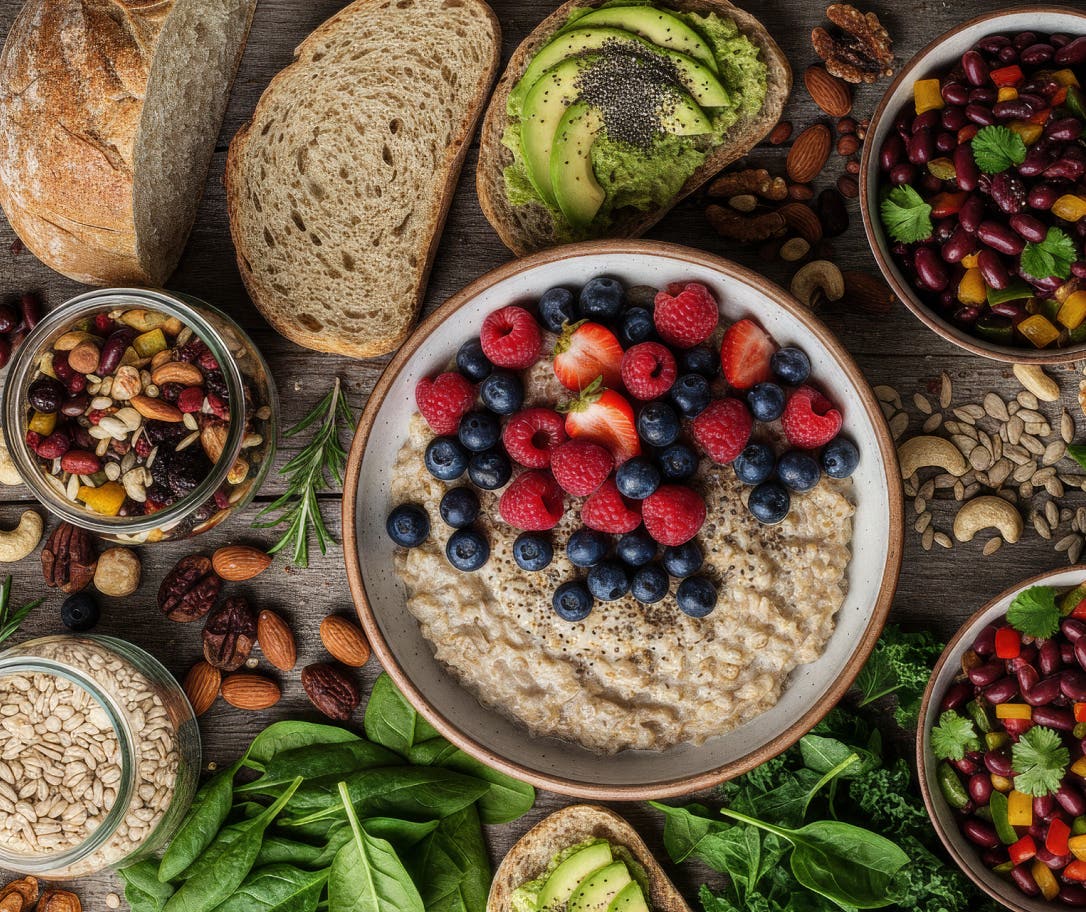Dietary fiber is a type of carbohydrate that’s found in plant foods like fruit, vegetables, wholegrains, nuts, and seeds that the human body is unable to digest or absorb. Unlike other macronutrients, such as fats, proteins, and other carbohydrates, fiber travels through your digestive system relatively untouched until it reaches your large intestine.
But that doesn’t mean it is nutritionally useless. In fact, fiber is an essential part of the diet, one that’s crucial for good health. There are two main types: soluble and insoluble fibers, and each one has crucial roles in supporting your body and health.
Soluble fiber
Soluble fiber dissolves in water, forming a gel-like substance. It’s found in food like oats, flaxseeds, beans, lentils, and psyllium husk. When it reaches your gut, soluble fiber can slow down digestion, making you feel fuller for longer, and can regulate fat and sugar absorption.
That’s not all, soluble fiber has prebiotic properties, which means it feeds the beneficial bacteria residing in your gut. In doing so, these strains produce useful metabolites like short-chain fatty acids and vitamins.
Insoluble fiber
Insoluble fiber, also known as roughage, doesn’t dissolve in water. Instead, it helps firm up your stool to keep things moving through your digestive system. Insoluble fiber is found in the skins, stalks, bran, and seeds of plant foods.
By helping food pass through the intestines, insoluble fiber helps to prevent and alleviate constipation and promote bowel regularity. This indirectly helps to promote energy levels and nutrient absorption.

The benefits of dietary fiber
Dietary fiber has several health benefits, including:
- Supports digestion – Since fiber cannot be digested in the stomach, it passes through the digestive tract to the colon, where it nourishes beneficial gut bacteria. Additionally, it helps bulk up our stools, preventing constipation and promoting regularity.
- Supports heart health – some fibers, like beta-glucan and psyllium, have cholesterol-lowering properties, particularly bad or LDL cholesterol.1
- Promotes a healthy and diverse gut microbiome – Eating plenty of fiber helps to keep your gut bacteria nourished, which helps to keep your microbiome diverse and abundant.2
- Keeps you feeling fuller for longer – Because it takes a while for fiber to be digested compared to other nutrients, it can keep you feeling satisfied for longer, which can prevent overeating and unnecessary snacking. Dietary fiber intake is linked to lower body weights.3
- Lowers blood pressure – research shows that eating just an extra 5 g of fiber per day can lower systolic blood pressure by 2.8 mm Hg and diastolic blood pressure by 2.1 mm Hg.4
- Controls blood sugar – dietary fiber intake can improve blood sugar control and weight management in people with type 2 diabetes.5
What foods contain dietary fiber?
Fiber is naturally found in plant foods, which means it is easy to incorporate into your daily, well-balanced diet. Some examples of fiber-rich food sources include:
- Whole grains – oats, quinoa, whole wheat bread, brown rice
- Fruits – apples, pears, berries, oranges, bananas
- Vegetables – artichokes, broccoli, Brussels sprouts, carrots, spinach
- Legumes – beans, chickpeas, kidney beans, lentils
- Nuts and seeds – almonds, Brazil nuts, chia seeds, flaxseeds, sunflower seeds, walnuts
Processed foods lose a lot of their fiber content during the manufacturing process, so it’s important to choose whole, minimally processed plant foods when possible.
How much fiber do I need per day?
Dietary fiber recommendations can vary between countries, and men and women may need different amounts, but some general guidelines are as follows:
| Men | Women |
| NHS recommendations6 | 30 g/day | 30 g/day |
| NIH recommendations7 | 38 g/day | 25 g/day |
Despite these recommendations, many people in Europe and the US fall well below these amounts, averaging 18 to 24 g/day for men and 16 to 20 g/day for women. That means that most people need to increase their fiber consumption by around 50% daily to meet their current needs.8
What if I eat too much fiber?
Although fiber is good for you, eating too much at once or not gradually building up your tolerance if you currently eat very little can lead to digestive discomfort, such as:
- bloating
- gas
- diarrhoea
- constipation
- abdominal pain
It’s important to increase your fiber intake slowly and make sure you drink plenty of water to reduce the chance of these uncomfortable side effects.
If you eat too much fiber and you are experiencing any of these symptoms, you can try:
- drinking plenty of water
- stop taking any fiber supplements
- avoid high-fiber foods until the feeling has passed
- keep a food diary to identify any foods that may be irritating you and to keep track of how much fiber you are eating
- spread your fiber consumption throughout the day rather than in one go
- start slowly and build up gradually

What if I don’t eat enough fiber?
Equally, eating too little fiber can also negatively impact your digestive and overall health. It’s crucial to strike a good balance and eat a healthy amount of roughage per day. If you do not eat enough fiber, it can cause:
- constipation
- hunger
- energy fluctuations
- irregular bowel movements
- weight gain
- increased risk of chronic diseases, including type 2 diabetes and heart disease
Fiber and exercise: What you need to know
Athletes can benefit from dietary fiber because of its roles in digestion, energy, and blood sugar control, but there are a few things to consider when eating it. For example, the timing when you eat and the amount of fiber you consume, particularly before a workout, is important.
Try to avoid high-fiber meals 2 hours before working out or before a competition, as it can cause bloating or digestive discomfort that may impact your performance. Instead, save high-fiber meals for post-workouts and rest days to replenish nutrients, support gut health, and keep your energy levels up between sweat sessions.
Hydration is also crucial when you’re increasing fiber intake, so make sure to drink plenty of water to prevent constipation and discomfort – something no athlete wants mid-training.
Focus on fueling with whole, nutrient-dense foods like fruits, vegetables, whole grains, and legumes, which provide fiber along with vitamins, minerals, and other key nutrients to boost your performance and speed up recovery.
Let’s recap
Fiber is an important part of a healthy diet, and there are many things you can do to ensure you’re hitting your daily needs. And it doesn’t have to be boring and bland – in fact, the more variety, the better. Here are some of our top tips to increase your fiber consumption:
- Start the day with a slice of whole-grain toast or a warming bowl of snickers porridge
- Swap white bread, pasta, and rice for wholemeal and granary breads, brown or wild rice, and wholemeal pasta
- Eat fruit, vegetables, and potatoes with their skins on, where possible, because this is where a large amount of fiber is found
- Bulk up stews, soups, curries, and salads by adding pulses, like beans, lentils, and chickpeas, to them
- Use chia or flaxseeds as a topping for yoghurt, porridge, and smoothies
- Try fruit, vegetable sticks, rye crackers, oatcakes, and unsalted nuts for snacks
Sources
[1] McRorie, J. W., Jr, & McKeown, N. M. (2017). Understanding the Physics of Functional Fibers in the Gastrointestinal Tract: An Evidence-Based Approach to Resolving Enduring Misconceptions about Insoluble and Soluble Fiber. Journal of the Academy of Nutrition and Dietetics, 117(2), 251–264. Available here
[2] Fu, J., Zheng, Y., Gao, Y., & Xu, W. (2022). Dietary Fiber Intake and Gut Microbiota in Human Health. Microorganisms, 10(12), 2507. Available here
[3] Clark, M. J., & Slavin, J. L. (2013). The effect of fiber on satiety and food intake: a systematic review. Journal of the American College of Nutrition, 32(3), 200–211. Available here
[4] Jama, H.A. et al. (2024) ‘Recommendations for the use of dietary fiber to improve blood pressure control’, Hypertension, 81(7), pp. 1450–1459. Available here
[5] Nitzke, D., Czermainski, J., Rosa, C., Coghetto, C., Fernandes, S. A., & Carteri, R. B. (2024). Increasing dietary fiber intake for type 2 diabetes mellitus management: A systematic review. World journal of diabetes, 15(5), 1001–1010. Available here
[6] NHS. (2022). How to get more fibre into your diet. Available here
[7] Akbar A, Shreenath AP. High Fiber Diet. [Updated 2023 May 1]. In: StatPearls [Internet]. Treasure Island (FL): StatPearls Publishing; 2025 Jan-. Available here
[8] Barber, T. M., Kabisch, S., Pfeiffer, A. F. H., & Weickert, M. O. (2020). The Health Benefits of Dietary Fibre. Nutrients, 12(10), 3209. Available here